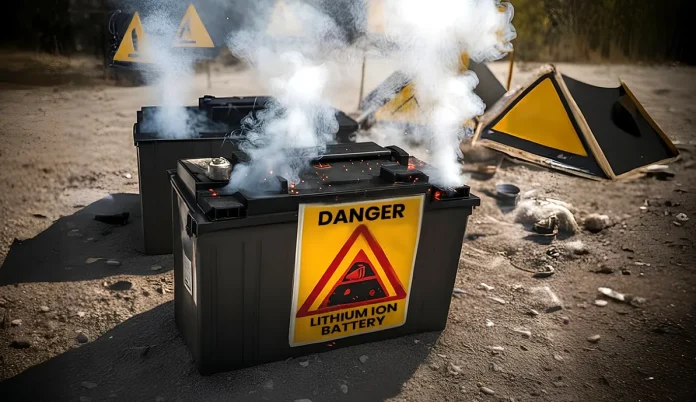A silent crisis is burning its way through the so-called clean energy revolution. As the world rushes to embrace electric mobility, renewable energy storage, and digital convenience, lithium-ion batteries, the compact powerhouses behind it all, are revealing a darker side. Across recycling plants, homes, and factories, reports of fires, explosions, and toxic leaks are mounting. What was once hailed as the technology of the future is fast becoming a symbol of uncontrolled risk and environmental hypocrisy.
In recycling centres nationwide, workers are increasingly encountering lithium-ion batteries discarded among everyday waste, batteries that can ignite with little warning. Industry insiders describe a grim trend: more fires, more losses, and more near-misses. The danger is not confined to industrial facilities. The same faulty or damaged batteries found inside home inverters, solar storage systems, and personal gadgets can turn convenience into a potential catastrophe.
According to recent reports from Recycling Today, lithium-ion batteries are now among the leading causes of fires at recycling facilities across the United States. These fires erupt when discarded batteries are crushed or punctured during sorting or transportation, triggering a thermal runaway, a chain reaction that leads to uncontrollable heat and flames. Once ignited, lithium fires can burn for hours and release toxic fumes, putting workers and nearby communities in grave danger.
“The recycling industry is under siege,” says Mark Hughes, operations manager at a California waste recovery plant that suffered a lithium fire last year. “We’ve had to shut down entire lines because a single battery slipped through the system. It’s not just about property damage, it’s about lives on the line.”
For years, lithium-ion batteries have been promoted as the heart of a sustainable energy future. The power of electric vehicles is meant to reduce emissions and store renewable energy from solar panels and wind farms. But the environmental promise masks a chemical reality few consumers understand.
Each lithium battery contains flammable electrolytes and metals such as cobalt and nickel. When overheated, punctured, or overcharged, these materials become volatile, leading to explosions or chemical leaks. Worse, they are challenging to extinguish once they are burning. Water often worsens the fire, spreading molten lithium and intensifying the reaction.
“People are storing them in their homes, unaware they’re sleeping next to a bomb,” says Dr Elaine Porter, an environmental safety researcher. “One faulty cell or a damaged inverter battery can ignite an entire household.”
Recycling experts warn that the problem begins long before the disposal of materials. Poor design, inadequate labelling, and inconsistent manufacturing standards make it almost impossible to manage lithium batteries safely at scale. Many low-cost imports, especially inverter batteries sold online, lack crucial safety features such as thermal cutoffs or flame-retardant coatings.
Recent incidents paint a worrying picture. A central recycling facility in Arizona was forced to close after a lithium battery fire caused over $5 million in damage. In New York, firefighters battled a blaze at a waste-sorting plant that smouldered for three days. Closer to home, a family in Texas lost their garage, and nearly their lives, when a home inverter battery caught fire while charging.
These fires are not isolated accidents but symptoms of a deeper systemic failure. With billions of lithium batteries entering the waste stream each year, even a fraction mishandled is enough to create a national hazard. The Environmental Protection Agency (EPA) estimates that battery-related fires in waste facilities have increased by a factor of three in the past five years.
Yet regulation has failed to keep pace. Lithium batteries are often mixed with household recyclables or tossed in garbage bins. Once compacted or crushed in recycling trucks, they ignite instantly, a fire hazard few municipal systems are equipped to manage.
“We’re treating hazardous materials like everyday trash,” says Hughes. “It’s madness.”
As solar power adoption rises, lithium-ion inverter batteries have become a common feature in American homes. Marketed as “clean, quiet, and efficient,” these devices store energy for use during outages or peak demand hours. But experts warn that they carry the same explosive potential as their industrial counterparts, sometimes worse, due to poor installation or substandard manufacturing.
“Home systems are often installed without proper ventilation or temperature control,” explains Dr Porter. “When an inverter battery overheats or suffers internal damage, it can enter thermal runaway just like the ones in recycling plants. The only difference is, this time the fire starts inside someone’s house.”
Once a lithium battery catches fire, toxic gases, including hydrogen fluoride and carbon monoxide, are released, posing serious respiratory and environmental risks. Firefighters say such blazes are exceptionally hard to control, requiring specialised equipment and hours of containment efforts.
Despite the escalating incidents, public awareness remains dangerously low. The sleek packaging of lithium-powered devices hides the explosive chemistry within. Consumers continue to purchase inexpensive, uncertified batteries online, unaware that a single faulty cell can ignite during charging or storage.
Government and industry responses have been sluggish. Recycling facilities are calling for stricter rules on battery disposal and more explicit labelling to help identify dangerous cells. Yet manufacturers resist tighter regulations, arguing that additional costs would slow innovation.
That tension has left consumers caught in the middle, promised green technology, but handed an unstable chemical product that endangers homes, communities, and the environment.
Experts insist the only real solution lies in rethinking the technology altogether. Safer alternatives, such as solid-state or sodium-ion batteries, are emerging, but they remain costly and are years away from mass production. Until then, prevention and awareness are the only defences against growing lithium battery hazards.
For consumers, that means handling inverter and rechargeable batteries with caution:
- Buy certified products from reputable brands.
- Avoid overcharging and store batteries in a cool, well-ventilated space.
- Never throw used batteries in household trash or recycling bins.
- Take damaged batteries to certified collection centres.
The lithium-ion battery may have powered humanity into the 21st century, but its safety failures are catching up fast. Fires are rising, regulations are lagging, and consumers are paying the price for a “clean energy” dream built on unstable chemistry.
The green revolution is running hot, and if we ignore the warning signs, it may just burn itself out.
Read the Latest Battery News Shaping the Global Power Market
References


